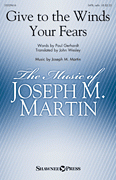Sunday, September 21, 2014
Give to the Winds Your Fears (words by Paul Gerhardt, translated by John Wesley; music by Joseph M. Martin; Shawnee Press 35029616)
Porter graciously waited in the airport so I could sing this one with the choir. It was a special day because we had a guest cellist to play with us. (You can hear the cello part with the anthem, though not our performance, at the link above). The anthem itself was notable for a couple of reasons. First, the words (albeit in translation) are by Paul Gerhardt, a German hymn writer I've come to appreciate thanks to Stephan's efforts. Second, although I'd never heard of this hymn before, I encountered it again in a Christianity Today article on the temperance movement. (I've included the link, but you'll only just be able to start reading this one unless you're a subscriber.)
Many temperance advocates also promoted voting rights for women. After all, women were more likely than men to vote to shutter the saloons that were destroying their homes. Carrie Nation and her hatchet may be the most famous image, but the 1873-74 Woman's Crusade—which led to the founding of the Woman's Christian Temperance Union (WCTU)—is a more accurate representation, with its crowds of nonviolent protesters linked arm-in-arm before saloon doors. A later WCTU historian described the crusade in Ohio:
Walking two by two, the smaller ones in the front and the taller coming after, they sang more or less confidently, "Give to the Winds Thy Fears," that heartening reassurance of Divine protection now known to every WCTU member as the Crusade Hymn. Every day they visited the saloons and the drug stores where liquor was sold. They prayed on sawdust floors or, being denied entrance, knelt on snowy pavements before the doorways, until almost all the sellers capitulated.
Here's something else I learned from the article:
There are a number of misconceptions about the 19th-century temperance movement. The first, which was shared by temperance activists themselves, is that it didn't work. In fact, it did. American drinking dropped dramatically after the temperance movement took off in the 1830s. Americans in 1830 were drinking 7.1 gallons of absolute alcohol per year per person. ... By 1835, they were down to 5.0 gallons; by 1840, 3.1. By 1910, shortly before Prohibition, this had dropped to 2.6 gallons; post-Prohibition, it was down to 1.2.... Even after every moral loosening the 20th century wrought, from flappers to the counter-culture movement, by the year 2000, the average American drank less than a gallon of absolute alcohol. That's more than six gallons less a year than their ancestors had about 200 years before.
Am I missing the math mistake, or does this quote include the corrected numbers?
The mistake is cleverly hidden by ellipses above. Apparently trying to make the numbers more accessible, the author included the parenthetical statements "That's the equivalent of drinking 36 bottles of wine in a year," and "about 6 bottles of wine in a year" where I have the ellipses. In the online, corrected version, "bottles of wine" has been replaced by "750ml bottles of pure alcohol." (750 ml is a common wine bottle size.) Given that wine is generally between 9 and 16 percent alcohol (most commonly around 13%), you can see why I was having a hard time making 36 bottles into 7.1 gallons of alcohol. One bottle of wine in about a week and a half is certainly more than we drink, but hardly the excess the article is examining.
So, with an average of 13%, and a lot of rounding, we end up instead with 270 bottles of wine per year, or a bit more than a daily bottle of wine Mon-Fri. That is a lot indeed!



